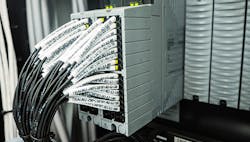While researching several Ethernet/Internet-related topics recently, I found that my sources kept bringing up IO-Link field device protocol as a useful way to extend their networks and enable their processes. This wasn't a surprise because the IEC 61131-9 standard for short distance, point-to-point, wired or wireless networking is becoming increasingly popular for connecting digital sensors, actuators and other devices to higher-level fieldbuses or Ethernet networks.
However, IO-Link still bugs me, because its emergence and how it operates run counter to how I was told industrial networking was supposed to evolve. In the past couple of decades, hardwired, point-to-point networks often gave way to low-power fieldbuses and later Ethernet and wireless versions, which snaked among and linked up multiple devices, and allowed them to communicate on one telephone-style loop back to a central device. It makes sense that running one wire or wireless signal among a bunch of components is less costly and time-consuming than sending a dedicated cable out to reach each component and needed signal, right?
Sounds reasonable, but just as flies get into ointments, reality and other unforeseen snags intrude. Most require reassessments of issues we thought were settled, as well as a more closely reexamined and deeper understanding of what we thought we already knew.
A couple of end users and experts reminded me that fieldbuses and Ethernet may have initial advantages over point-to-point hardwiring. However, once their loop is landed, they usually require added configuration and programming, which most plant-floor technicians aren't trained to handle and most 9-to-5 information technology (IT) staffs aren't available to deal with. This can cut into the benefits of fieldbuses and Ethernet, and makes all their bells and whistles less of the terrific deal they promised at first.
For example, in his presentation at the ODVA conference in March, Paul Maurath, technical director for power, control and information systems at Procter & Gamble, reported that his team is testing multiple IO-Link devices on P&G's Smart Process Cell (SPC) demonstration project in conjunction with evaluating Ethernet-Advanced Physical Layer (APL) for likely future deployments. (For more, see this issue's "Great expectations" cover story on page 20).
Consequently, despite its physical requirements, IO-Link can provide a simple, close to plug-and-play bridge between numerous field devices and many networking protocols, and apparently do it without much of the programming required by its more digitalized counterparts. And, because many fieldbuses and Ethernet networks are increasingly widespread on plant floors and field operations, I/O-Link often doesn't have to go too far to reach higher-level networks, and give them the last-mile access they need to reach device-level equipment and processes.
It's ironic how much point-to-point hardwiring can help the Internet and other forms of digitalization that are supposed to replace it. Of course, this is similar to the logical assumption that wireless was going to replace wires, which actually resulted in more hardware and wiring on its transmitting and receiving ends. This is where some of that deeper understanding about what's actually happening with industrial networking—or anything else—can occur and come in handy.
At the same time, IO-Link isn't a cure-all. Much of its appeal depends on its master-slave structure, which is familiar to many users. They may appreciate its simplicity and lack of required programming, but is this preference because training in configuring Ethernet and digitalized networking isn't available or because they refuse it?
Either way, many users and their processes will continue to be stuck in the no man's land between IT and operations technology (OT) as they continue their epic struggle to come together. As usual, the only solution is breaking down this huge, overall goal into smaller tasks, and making incremental gains. IO-Link can be one of the steps forward, if it isn't used as a crutch.
About the Author

Leaders relevant to this article:


